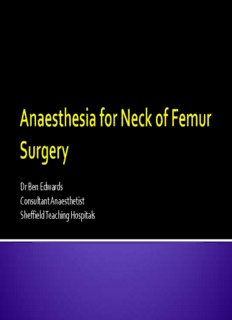
Anaesthesia for #NOF PDF
Preview Anaesthesia for #NOF
Dr Ben Edwards Consultant Anaesthetist Sheffield Teaching Hospitals 70-75,000 #NOF per annum (costs £2 billion) 10% die within 1 month 33% die within 1 year Operative delays >48hs more than doubles risk of post op complications DVT, pneumonia, UTI Surgery is the best analgesia NICE & AAGBI guidelines (Oct 2013 ) NICE recommend the following should happen: Pain is assessed and treated Obtain imaging X-ray MRI/CT if clinical suspicion but x-ray negative All patients receive formal acute Orthogeriatric / Orthopaedic ward-based Hip Fracture Programme Assess the patient’s pain: immediately upon presentation at hospital And within 30 mins of administering initial analgesia And hourly until settled on the ward And regularly as part of routine nursing observations throughout admission. Ensure sufficient analgesia to allow movements necessary for investigations, nursing care & rehabilitation. NSAIDs are not recommended. Paracetamol until U&E’s ok – then opiods Fascia Iliaca blocks commonly sited in ED 70% of patients are ASA 3-4 35% have one co-morbidity 17% have 2 7% have >3 The most common co-morbidities: Cardiovascular 35% Respiratory 14% Cerebrovascular 13%, diabetes 9% Malignancy 8% Renal disease 3% FBC, group & save: anaemia is present in 40% higher blood transfusion trigger in the elderly i.e. Hb < 90 g/L (< 100 g/L with ischaemic heart disease) Leukocytosis and neutrophilia are common may represent a reaction to trauma rather than infection. Clotting A platelet count of < 80 is a relative contraindication to neuraxial anaesthesia. Platelet count < 50 will usually need a platelet transfusion. U&E Hyper and hypokalemia, and hyponatraemia are common. ECG required in all patients with a NOF. CXR not necessary for all patients but useful in those with pneumonia or heart failure. Perform surgery on the day of, or the day after admission Identify and treat correctable co-morbidities immediately to avoid delaying surgery
Description: